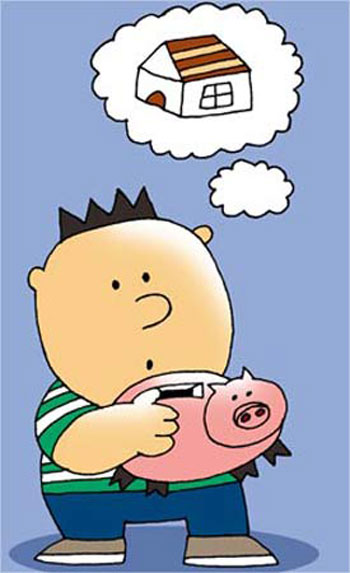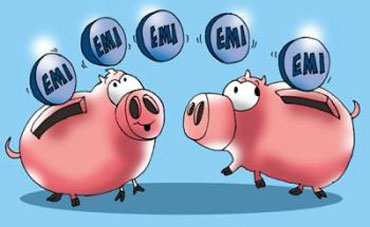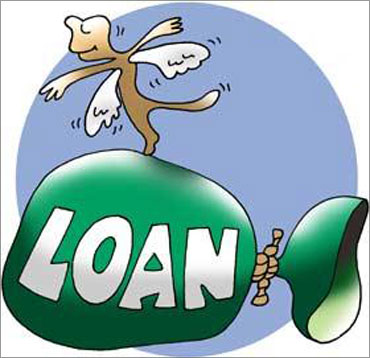 | « Back to article | Print this article |
Home loan: Fixed, floating or hybrid?
One of the major decisions revolving around purchasing a home is the type of home loan you should take. Primarily, you have to make a choice between two basic types of loans -- fixed rate home loans and floating rate home loans.
The main difference in these loans is the interest rates. Let us discuss these different types of loans here.
Fixed rate home loans
As the name indicates, the rate of interest payable on this type of home loans remains constant throughout the term of the loan. Therefore, you are certain about the amount of regular cash outflow each month. Thus, it is easier to plan your finances.
A fixed rate also shields you against increase in money market rates. So, if you have taken a loan at 10 per cent p.a. for a term of 15 years and the interest rates increase to 13 per cent p.a. in five years, you continue to pay interest at the rate of 10 per cent.
However, this may not always be the case. This is because most banks include a 'Force Majeure' clause or a 'Money Market' clause in their loan agreement by which they are entitled to modify the interest rate after a fixed term in the event of substantial changes in the money market conditions.
So, even though the interest rate is fixed, it may alter if conditions change significantly from the time when the loan was taken. Therefore, if you choose a fixed rate home loan, be sure to read the agreement thoroughly and understand all the clauses.
It is best to go with a lender who offers home loans without the force majeure clause. Alternatively, you can try to negotiate with your lender to exclude such a clause from your agreement.
Click NEXT to read on . . .
Home loan: Fixed, floating or hybrid?
On the flip side, the interest rate on fixed rate loans is generally higher than floating rates. Consequently your monthly outflow is larger and your total outgo on account of interest payments is considerably bigger as compared to floating rate loans for similar amount and tenure.
For example, HDFC charges interest of 8.25 per cent for a floating interest loan as against 14.25 per cent for a fixed interest loan. However, some banks like SBI do not keep any significant difference in their interest rates for either type of loans.
Let us take a look at your EMI (equated monthly instalment) schedule if you opt for a fixed interest loan for an amount of Rs 25 lakh (Rs 2.5 million) for a term of 10 years, interest charged at 14.25 per cent p.a.
| Year | Starting Balance | Interest paid | Principal paid | Year-end balance |
| 1 | 25 lakh | 3.48 lakh | 1.22 lakh | 23.78 lakh |
| 2 | 23.78 lakh | 3.30 lakh | 1.40 lakh | 22.38 lakh |
| 3 | 22.38 lakh | 3.08 lakh | 1.62 lakh | 20.76 lakh |
| 4 | 20.76 lakh | 2.84 lakh | 1.86 lakh | 18.90 lakh |
| 5 | 18.90 lakh | 2.56 lakh | 2.15 lakh | 16.75 lakh |
| 6 | 16.75 lakh | 2.23 lakh | 2.47 lakh | 14.28 lakh |
| 7 | 14.28 lakh | 1.85 lakh | 2.85 lakh | 11.43 lakh |
| 8 | 11.43 lakh | 1.42 lakh | 3.29 lakh | 8.14 lakh |
| 9 | 8.14 lakh | 0.92 lakh | 3.78 lakh | 4.36 lakh |
| 10 | 4.36 lakh | 0.34 lakh | 4.36 lakh |
|
| 1 lakh = 100,000 | ||||
Your total outflow on repayment of the loan is Rs. 47.03 lakh, Interest amount paid comes to Rs. 22.03 lakh.
Click NEXT to read on . . .
Home loan: Fixed, floating or hybrid?
Floating rate home loans
In this type of loan the interest rate is flexible and moves with the current market interest rates. Generally, banks peg their floating rates to their base rates.
So, if the interest rates fall, your floating rate should also decline and vice versa. Floating rates are lower than fixed rates. Floating rates are adjusted periodically, say, every six months.
Earlier, the benchmark that banks used was their own PLR and they would make upward revisions in the interest rates but interest rates on loans never came down when the money market rates fell.
Now the banks are using the system of base rates. We are yet to see the impact of this change on floating rate loans. However, base rates have to be updated every quarter.
Hence, borrowers will most likely get the benefits of falling interest rates henceforth.
Click NEXT to read on . . .
Home loan: Fixed, floating or hybrid?
Let us take a look at your EMI schedule if you opt for a fixed interest loan for an amount of Rs 25 lakh for a term of 10 years, interest charged at 8.25 per cent p.a.
Assume that the bank increases your rate to 9 per cent in Year 3 and reduces the rate to 8.00 per cent in Year 8.
| Year | Starting Balance | Interest paid | Principal paid | Year-end balance |
| 1 | 25 lakh | 2.00 lakh | 1.68 lakh | 23.32 lakh |
| 2 | 23.32 lakh | 1.86 lakh | 1.82 lakh | 21.50 lakh |
| 3 | 21.50 lakh | 1.86 lakh | 1.92 lakh | 19.57 lakh |
| 4 | 19.57 lakh | 1.68 lakh | 2.10 lakh | 17.47 lakh |
| 5 | 17.47 lakh | 1.48 lakh | 2.30 lakh | 15.17 lakh |
| 6 | 15.17 lakh | 1.26 lakh | 2.52 lakh | 12.65 lakh |
| 7 | 12.65 lakh | 1.03 lakh | 2.75 lakh | 9.90 lakh |
| 8 | 9.90 lakh | 0.68 lakh | 3.04 lakh | 6.86 lakh |
| 9 | 6.86 lakh | 0.43 lakh | 3.29 lakh | 3.57 lakh |
| 10 | 3.57 lakh | 0.16 lakh | 3.57 lakh |
|
| 1 lakh = 100,000 | ||||
Your total outflow on repayment of loan is Rs 37.44 lakh, interest paid comes to Rs 12.44 lakh. Due to the large difference in the basic rates, interest outgo for fixed rate loans is considerably higher. However, the borrower takes the risk of interest rate hikes.
Hybrid loans
In an attempt to combine the benefits of fixed and floating interest rates, banks also offer hybrid loans where the borrower pays a fixed interest on a portion of the loan and a part of the loan is charged interest on floating rate.
Powered by
BankBazaar.com is an online marketplace where you can instantly get loan rate quotes, compare and apply online for your personal loan, home loan and credit card needs from India's leading banks and NBFCs.
Copyright 2025 www.BankBazaar.com. All rights reserved.



